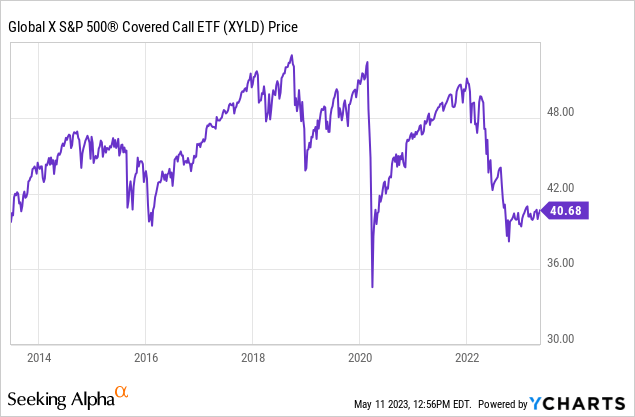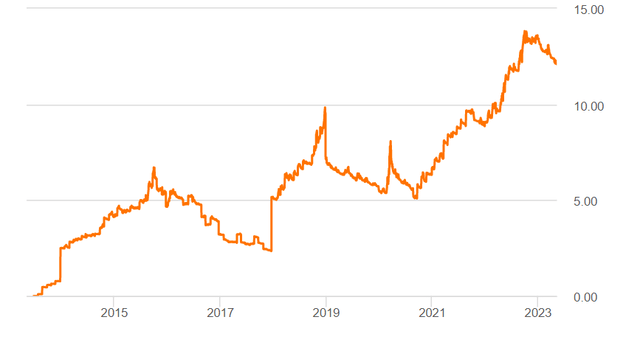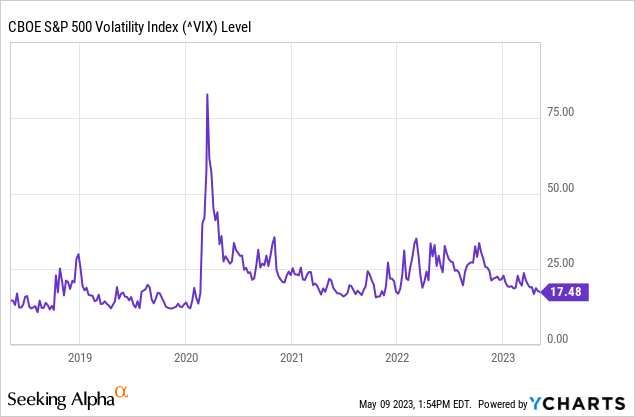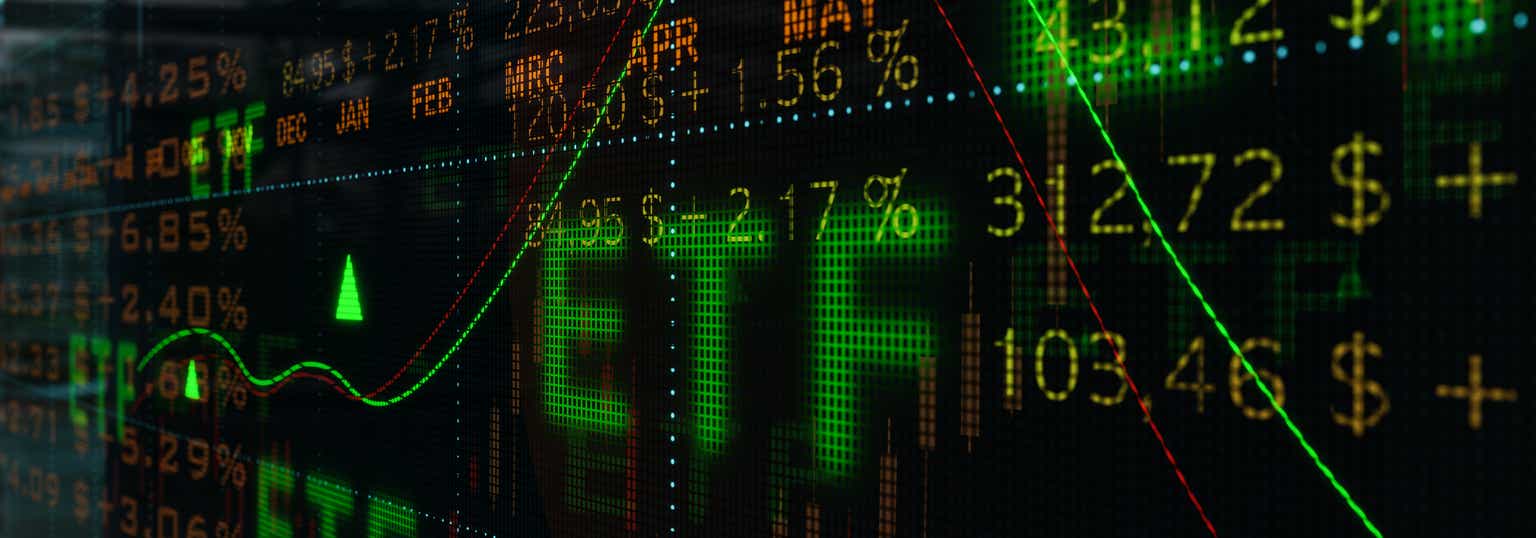The economic environment has changed dramatically in the last several years. With prices rising at levels consistently above 5%, interest rates going up, and signs of a recession now increasing, investing has become more difficult.
Few investors have been more impacted by increasing prices and rising rates than those who primary goal is income. Dividend investors have been forced to be more creative to get the inflation-adjusted returns. With inflation rates coming in consistently at 5% or higher for the last several years, traditional fixed income and equity investments have offered minimal overall returns.
One type of investment that has become increasingly popular over the last several years with dividend and income investors is covered call funds. One of the more well-known covered call funds is the Global X S&P 500 Covered Call ETF (NYSEARCA:XYLD).

This fund has performed well since its inception nearly 10 years ago in June of 2013. This ETF is up 91% over the last 9 years and 11 months. While the S&P 500 (SPY) is up 199.50% during this same time period, most investors in covered called funds are primarily seeking income. This fund has consistently paid out an average of nearly 10% per year in annual distributions, with payouts being made monthly.
I wanted to update my coverage of The Global X S&P 500 Covered Call ETF from when I wrote my previous article on this fund in March of this year. I continued to rate this fund a buy in March, but I now view this fund as a strong buy since there are increasing signs the economy will likely enter a recession in the coming months. This covered call fund performs best when volatility levels are elevated, and fear levels should increase as the economy likely continues to slow throughout 2023. This ETF should continue to be able to consistently offer investor double-digit annual income without significant risk to the principal is what will likely an uncertain investing environment for some time.
The options strategy that the managers of XYLD use is selling monthly at-the-money call options to make monthly distributions. This ETF tracks the CBOE’s S&P 500 buy and write index through the purchase of individual holdings and then the selling of monthly at-the-money calls against the equities held. XYLD sell calls up to 100% of the value of the equities the fund holds. This fund’s holdings are indexed to the S&P 500. XYLD is invested in 26% technology, 14% health care, 12.69% financials, 10.39% consumer cyclicals, 8.18% communication, 8.43% industrials, 7.17% consumer defensives, 4.6% energy, 2.62% real estate, 2.85% utilities, and 2.36% basic materials. This indexed fund has a good balance between cyclical companies that are more volatile during slower phases of the business cycle, and more defensive sectors such as consumer staples and health care. XYLD is also mostly invested in large cap since the ETF is indexed to the S&P 500, which also lower the risk-profile of the fund.
XYLD has an expense ratio of .6%, which is normal for a more complicated asset structure as we see with this ETF. The total assets under management of this fund are $2.65 billion, and payouts are made monthly. These distributions will vary based on the income the fund receives from selling covered calls, and the payouts will mostly vary with the volatility levels in the monthly call options being sold. The annual dividends and income this fund offers have consistently been above 10% since the fund’s inception nearly 10 years ago. The current yield of the fund is 12.09%.
A Chart showing XYLD’s distributions (Seeking Alpha)
This fund’s monthly and annual payouts have consistently risen since over the last 9 years, primarily because higher levels of volatility have increased the implied volatility premiums in the call options that this fund sells against the equity holdings. Overall volatility levels have been significantly higher in the market over the last 3 years since the Pandemic hit in late 2019.
A Chart of the VIX (Seeking Alpha)
This fund performs best when volatility levels are elevated but the risk to the principal is not excessive. Today there are increasing signs that the economy is likely to enter a recession, the Fed remains committed to raising rates, and inflation levels continue to come in at high levels. April’s inflation data showed prices rose at 4.9%. Volatility levels in the market are likely to stay elevated for some time, although a huge sell-off remains unlikely with S&P 500 earnings still holding up reasonably well. The number of positive earnings surprises recently came in above the 10-year average.
This fund also has a standard deviation of 13.62, which is below the median standard deviation for ETF’s of 22.96, but still high enough for this fund to outperform using the options strategy the managers of this ETF utilize. This is an ideal market environment for covered call funds such as XYLD, and this fund should continue to significantly outperform standard long funds and the broader indexes if the economy enters a recession. XYLD has also outperformed other covered call funds such as the Global X S&P 500 Covered Call & Growth ETF (XYLG) and the Global X Nasdaq 100 Covered Call ETF (QYLD). XYLG differs primarily from XYLD since that fund sells calls against only half of the ETF’s holdings.
All investments have risk, and if the economy were to enter into a deeper recession, or large bank failures create excessive levels of volatility, this fund would underperform in the short-term since the covered call strategy used by XYLD sells off upside without downside protection. If the economy avoids a recession and inflation rates fall significantly, volatility levels are obviously likely to drop closer to pre-Covid levels, which would of course hurt the fund’s monthly distributions.
Still, the markets have been rangebound for a while, and with signs of a recession increasing and inflation levels remaining high, the S&P 500 and most of the broader indexes are likely to offer minimal income and total runs for some time. The Global X S&P 500 Covered Call fund enables investors to profit from a what should be a more volatile market without taking excessive risks, since this indexed fund is well diversified and holds primarily large cap companies that have strong balance sheets. With uncertainty and fear levels likely to remain elevated for some time, this fund should continue to outperform.
Read the full article here




